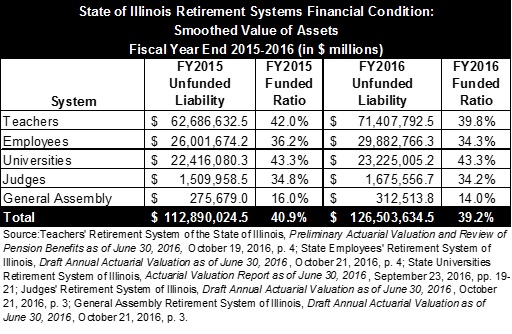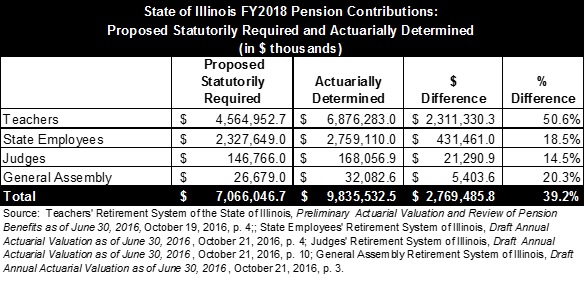November 03, 2016
Illinois’ contributions to its five pension funds are expected to increase by approximately $994 million in the upcoming fiscal year, putting more financial strain on a state that has been without a complete budget for the past 16 months.
In late October, trustees of the retirement systems approved proposed State contributions totaling $8.820 billion for FY2018, which begins on July 1, 2017. That represents an increase of 12.7% from contributions of $7.826 billion in FY2017.
The following table, based on FY2016 actuarial reports, shows total State pension contributions for FY2017 and proposed contributions for FY2018 for each of the systems: the Teachers’ Retirement System (TRS), State Employees’ Retirement System (SERS); State Universities Retirement System (SURS); Judges’ Retirement System (JRS); and General Assembly Retirement System (GARS).

Under State law, the funds must submit proposed contribution amounts for the next fiscal year by November 1 to the State Actuary, who issues any recommendations for changes by January 1. Final certified contribution amounts from the systems are due by January 15 so they can be included in the Governor’s budget recommendation in February.
As discussed here, significant increases in statutorily required FY2018 contributions were expected after two of the biggest funds, TRS and SERS, voted several months ago to revise assumptions that affect the estimated value of pension obligations.
One of the key assumptions involves the discount rate, the interest rate used to estimate the present value of future benefit payments. Reducing the rate increases the estimated present value because more money must be set aside now to pay future benefits. This present value, known as the actuarial liability, is compared with the value of pension assets to determine the funded status of pension plans and the level of State contributions. Public pension funds generally use the long-term assumed rate of investment return to discount liabilities for funding purposes.
TRS, which covers public school teachers outside of Chicago, reduced its assumed return to 7.0% from 7.5% based on expectations that investment returns will remain low over the next several years. That move, along with changes in other assumptions, was responsible for more than two-thirds of the $578.4 million increase in the fund’s proposed State contribution to $4.56 billion in FY2018 from $3.99 billion in FY2017, according to a presentation by the system’s actuary.
The proposed State contribution to SERS increases by $313.2 million to $2.3 billion in FY2018 from $2.0 billion in FY2017. The SERS Board lowered its investment return assumption to 7.0% from 7.25% and raised its projections about future life expectancy.
The Boards of the two smallest funds, JRS and GARS, reduced their assumed returns to 6.75% from 7.0% and lowered assumed mortality rates. The State’s proposed contribution to JRS increases by 11.8%, or $15.4 million, to $146.8 million, while the proposed contribution to GARS rises by 22.8%, or $5.0 million, to $26.7 million.
The proposed FY2018 contribution to SURS increases by the smallest percentage—4.9%—or $82.4 million to $1.75 billion from $1.67 billion in FY2017. Unlike the other retirement systems, SURS did not make any changes to its actuarial assumptions that affected the FY2016 valuation. SURS last reduced its assumed returns as of June 30, 2014, to 7.25% from 7.75%.
Proposed FY2018 contributions for each of the pension funds also increase due to poor investment returns in FY2016, including losses of 0.10% for TRS and 0.82% for SERS. However, the impact of the low returns was moderated by the State’s use of asset smoothing to calculate the actuarial value of assets. Under asset smoothing, unexpected gains and losses in any fiscal year are recognized over five years.
It is important to note that pension contributions are expected to increase each year under the State’s 50-year funding plan that began in FY1996. After a 15-year phase-in period, the law requires the State to contribute a level percentage of payroll sufficient to bring the retirement systems’ funded ratios to 90% by FY2045. A funded ratio shows the percentage of accrued pension liability covered by pension assets.
The State’s funding plan defers a large portion of the required State contributions to future years, which has resulted in growth in the unfunded liability. Illinois pension funds have consistently ranked as among the worst funded of all the states, including in a recent survey by Bloomberg, which was based on FY2015 data.
The next table compares funded ratios and unfunded liabilities for Illinois’ five retirement systems at the end of FY2015 and FY2016, based on the market value of assets. The systems’ combined funded ratio declined to 37.6% at the end of FY2016 from 41.9% at the end of FY2015, while the total unfunded liability grew by $18.8 billion, or 16.9%, to $129.8 billion from $111.0 billion. Unfunded liability is the pension obligation that is not covered by pension assets.

The following table shows the same information based on asset smoothing. The combined funded ratio on a smoothed basis dipped to 39.2% at the end of FY2016 from 40.9% at the end of FY2015, and the total unfunded liability increased to $126.5 billion from $112.9 billion. Asset smoothing moderated the impact of investment losses in FY2016.

It should be pointed out that the increase in State contributions in FY2018 is still not sufficient to meet reasonable actuarial funding requirements. To comply with a new accounting standard for public pension funds, the State retirement systems have adopted funding standards for reporting purposes that differ from the Illinois funding plan. These funding policies for reporting purposes only are required under Governmental Accounting Standards Board Statement No. 67 and are used to calculate what is known as the Actuarially Determined Contribution (ADC), which is designed to reflect more standard actuarial practices.
The next table compares proposed FY2018 contributions with ADC amounts for four of the systems. For SURS, an ADC amount comparable to the proposed State contribution could not immediately be determined. Under more actuarially sound funding schedules, the four systems’ FY2018 contributions would be 39.2% higher than the amount proposed under the State’s existing funding plan.

The ADC amount for TRS is $6.9 billion, an increase of 50.6% from the proposed $4.6 billion. Under the State’s existing funding plan, TRS’ unfunded liability is expected to keep growing through FY2029, while the unfunded liability would decrease each year under the alternative funding plan.
